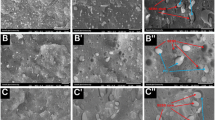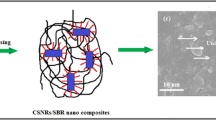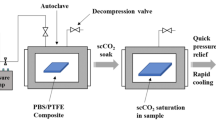Abstract
With the increasing difficulty in exploitation of low-permeability, high water content and other unconventional reservoirs, a new kind of proppants that possess not only ultra-light weight and high strength and but also hydrophobic performances have attracted more and more interests. Here, this kind of proppants were designed and prepared successfully in the form of polymer microspheres. What's more is that the polymer microspheres (named O-MSDBs) showing high strength and stable hydrophobicity were prepared by a one-step suspension polymerization between styrene, divinyl benzene and γ-methacryloxypropyl-trimethoxy silane accompanying with the formation of silica through sol–gel process. When compared with reported ultra-lightweight proppants (ULWPs), the O-MSDBs not only perform better in ultra-lightweight (0.9917 g·cm−3) and are comparable in high strength (low crushing ratio of 0.89–2.53% at 55–69 MPa), but also show new hydrophobic function. The water contact angle on the surface of O-MSDBs is 140.7° that keeps about more than 80% after mechanical abrasion or acid dissolution. The one-step facile preparation method and brilliant performances make O-MSDBs very promising to large-scale preparation and widely applied in fracturing technology as proppants.
Graphical Abstract







Similar content being viewed by others
References
Osiptsov AA (2017) Fluid mechanics of hydraulic fracturing: a review. J Pet Sci Eng 156:513–535
Barbati AC, Desroches J, Robisson A (2016) Complex fluids and hydraulic fracturing. In: PRAUSNITZ J M. Annual review of chemical and biomolecular engineering 7: 415–453
Barati R, Liang J-T (2014) A review of fracturing fluid systems used for hydraulic fracturing of oil and gas wells. J Appl Polym Sci 131:40735
Tang Y, Ranjith PG, Perera MSA (2018) Major factors influencing proppant behaviour and proppant-associated damage mechanisms during hydraulic fracturing. Acta Geotech 13:757–780
Liang C, Luo W, Yan C et al (2016) Ultra-lightweight proppant synthesized from PMMA/pine bark composite: low-cost material and outstanding properties. Chem Lett 45:994–996
Xu Y, Chen T, Hu J et al (2014) Study on preparation and properties of PMMA composite microspheres as the matrix of low density proppant. Appl Mech Mater 457–458:116–119
Chen T, Wang Y, Yan C et al (2015) Preparation of heat resisting poly(methyl methacrylate)/graphite composite microspheres used as ultra- lightweight proppants. J Appl Polym Sci 132:41924
Zhang Y, Yan C, Chen T et al (2016) Ultra-lightweight composite proppants prepared via suspension polymerization. J Compos Mater 50:2823–2831
Liang T, Yan C, Zhou S et al (2017) Carbon black reinforced polymethyl methacrylate (PMMA)-based composite particles: Preparation, characterization, and application. J Geophys Eng 14:1225–1232
Wang Y, Chen T, Yan C (2015) Reinforced performances of polymethyl methacrylate/silica fume composite spherical particles used as ultra-lightweight proppants. J Reinf Plast Compos 34:672–683
Liang T, Yan C, Zhou S et al (2017) Silica fume reinforced polystyrene-based composite particles used as ultra-light weight proppants in hydraulic fracturing. Mater Res Express 4:115306
Han X, Cheng Q, Bao F et al (2014) Synthesis of low-density heat-resisting polystyrene/graphite composite microspheres used as water carrying fracturing proppants. Polym Plast Technol Eng 53:1647–1653
Tasque JE, Vega IN, Marco S et al (2021) Ultra-light weight proppant: synthesis, characterization, and performance of new proppants. J Nat Gas Sci Eng 85:103717
Markovic G, Visakh (2017) PM. 1 - polymer blends: State of art. In: Visakh P M, Markovic G, Pasquini D. Recent developments in polymer macro, micro and nano blends. Woodhead Publishing. 1–15
Yong J, Chen F, Yang Q et al (2017) Superoleophobic surfaces. Chem Soc Rev 46:4168–4217
Ren X, Hu Q, Liu X et al (2019) Nanoparticles patterned ceramsites showing super-hydrophobicity and low crushing rate: the promising proppant for gas and oil well fracturing. J Nanosci Nanotechnol 19:905–911
Wang S, Liu K, Yao X et al (2015) Bioinspired surfaces with superwettability: new insight on theory, design, and applications. Chem Rev 115:8230–8293
Hench LL, West JK (1990) The sol-gel process. Chem Rev 90:33–72
Li X, Liu C, Gou K et al (2015) Effects of residual double bonds on the catalytic activity and stability of Pt/SDB hydrophobic catalysts. Rsc Adv 5:45420–45425
Al-Oweini R, El-Rassy H (2009) Synthesis and characterization by FTIR spectroscopy of silica aerogels prepared using severa Si(OR)4 and R’’Si(OR’)3 precursors. J Mol Struct 919:140–145
Tan L, Tan B (2017) Hypercrosslinked porous polymer materials: design, synthesis, and applications. Chem Soc Rev 46:3322–3356
Brooks BW (2010) Suspension polymerization processes. Chem Eng Technol 33:1737–1744
Zhang S, So LLC, Faucher S et al (2016) Polymer coating over solid particles with in situ thermal curing. Ind Eng Chem Res 55:5574–5584
Pangilinan KD, de Leon ACC, Advincula RC (2016) Polymers for proppants used in hydraulic fracturing. J Pet Sci Eng 145:154–160
Zoveidavianpoor M, Gharibi A, Binjaafar MZ (2018) Experimental characterization of a new high-strength ultra-lightweight composite proppant derived from renewable resources. J Pet Sci Eng 170:1038–1047
Ma R, Han X, Bao F et al (2016) Preparation and characterization of polymeric ultra-low-density proppants: Epoxy/phenolic resin-coated polystyrene/graphite microspheres. J Polym Mater 33:259–270
Funding
This work is supported by the Science and Technology Plan Project of Sichuan Province [2021YJ0348], Southwest University of Science and Technology of the Startup Foundation for Doctors [16ZX7139] and the Longshan Talent Program [17LZX675, 18LZXT01].
Author information
Authors and Affiliations
Corresponding author
Ethics declarations
Conflict of interest
The authors declare that they have no conflict of interest.
Additional information
Publisher's Note
Springer Nature remains neutral with regard to jurisdictional claims in published maps and institutional affiliations.
Rights and permissions
About this article
Cite this article
Song, L., Yuan, H., Gong, Y. et al. High-strength and long-term durable hydrophobic polystyrene microsphere: a promising ultra-lightweight proppant for fracturing technology. Polym. Bull. 79, 3665–3679 (2022). https://doi.org/10.1007/s00289-021-03683-0
Received:
Revised:
Accepted:
Published:
Issue Date:
DOI: https://doi.org/10.1007/s00289-021-03683-0




